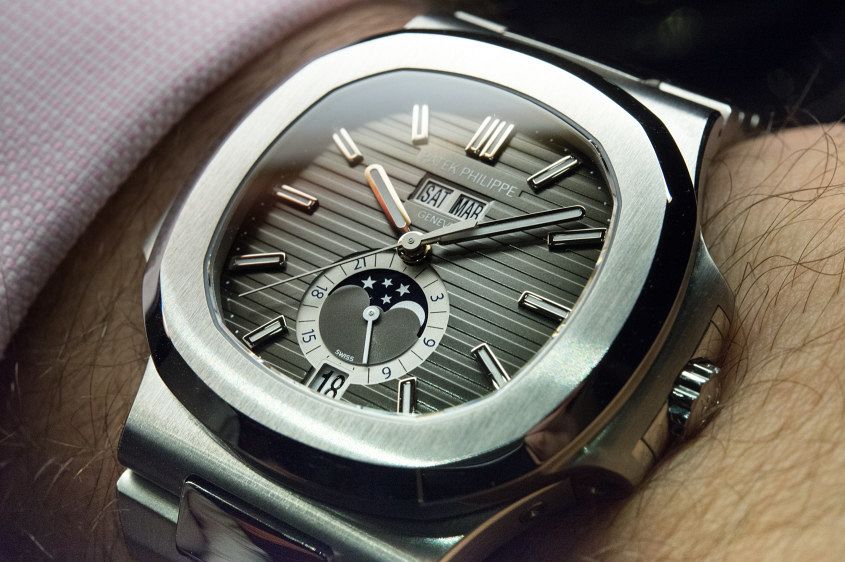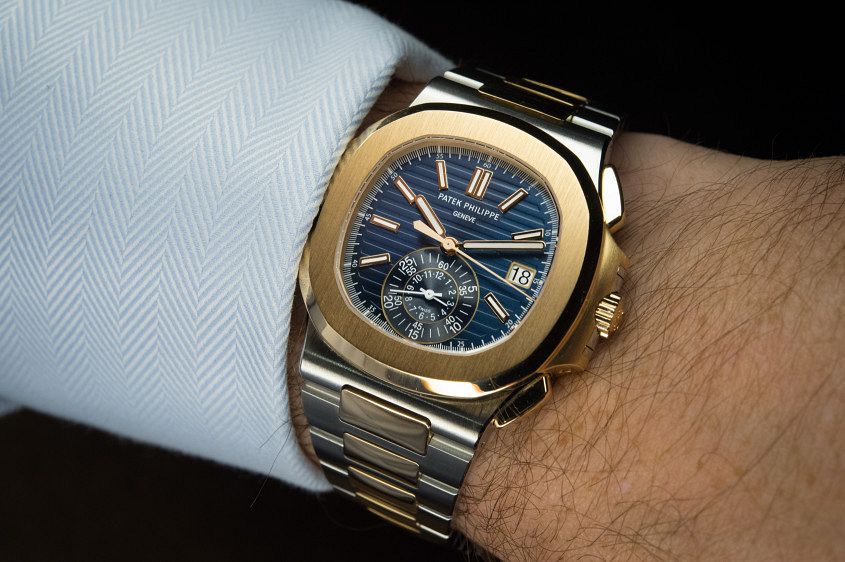A detailed breakdown of why the Patek Philippe Nautilus is, and always will be, the best steel sports watch of all time
Time+TideEditor’s note:The furore over the Patek Philippe Nautilus 5711 in recent years – that we have covered exhaustively – is interesting to consider in the context of this piece, that was written way back in 2014. It is essentially a long and detailed review of the new Nautilus models that were released that year. It was quite a collection, too. For Nautilus fans, this year had everything. And, from the perspective of 2020, which so far has been lean to say the least, this is a gluttonous feast. Along the way, we also mused on the history of the Nautilus and the era from whence it came. It’s a great read for those wanting to better understand the mythologised status of the Nautilus, which remains practically inaccessible (at RRP at least) to this day.

In the rarefied air of the high-end sports watch, the Patek Philippe Nautilus is still the King. You could fill your day reading pages of passionate prose that argue the merits of the watch relative to others, but there is something about the Nautilus that sets it apart from a less cerebral point of view. Pure feel.
In fact, when the Time+Tide editorial team sat down earlier this year and picked out a single ‘grail watch’, 66.6% of the team picked the Nautilus, while the other 33.3% were simply wrong. The Nautilus is certainly King in this dominion.
Before we get too much further into the Nautilus story, let’s firstly deal with some definitions. Yes, this is a ‘sports watch’, although obviously not a replacement for your G-shock or Garmin GPS watch. It comes from an era when there were “dress watches” (typically thin, classical watches in gold cases) and more casual ‘sports watches’, which were a little larger and bolder. But for ‘sports’, think Country Club sipping gin rather than surfing the breaks.

We had a chance to spend an evening ‘in the metal’ with the 2014 Nautilus range at a dinner organised by Patek Philippe and LK Boutique to mark Patek’s 175th anniversary. Given the rarity of the Nautilus in general and the worldwide demand for this latest collection, it was an amazing opportunity to see- and photograph-the majority of the 2014 range in the one place and compare the differences. For one member of the team, it was just the silken experience of endless Patek bracelets on the wrist that was the highlight of the evening. “The finishing, the finishing…!” was heard over and over again.
A Brief History of the Nautilus

Like many classics, the Nautilus didn’t meet with universal acclaim when it launched back in 1976. The design was a radical departure from the very traditional style of Patek’s existing range, with its larger size and- shock! horror!- stainless steel rather than gold case. Despite being steel, the Nautilus was no bargain, priced at $3,100 at launch, at a time when median annual income in the US was just over $12,000.

The 1970’s was a time when several design legends made their mark across different industrial fields. For example, in the car industry you had the brilliant Giorgetto Giugiaro changing the face of car design for Bertone and ItalDesign, while in watches, Gérald Genta created several models that are still considered iconic today, including the Omega Constellation and a trio of high-end steel sports watches: The Audemars Piguet Royal Oak, the Nautilus and IWC Ingenieur.
The defining elements of the original 3700 Nautilus design are the ‘ears’ on the side of the case (styled to remind owners of the porthole hinge on their mega yacht), the large octagonal bezel and the brilliant Black-Blue dial with its horizontal streaks. To celebrate the 30th anniversary of the Nautilus in 2006, Patek Philippe revamped the range with an updated case, a series of new movements and, for the first time, added a chronograph model.
Nautilus Design

The 2014 Nautilus stays true to Genta’s original design, with only a few detailed differences. For example, while the original 3700 had only an hour and minute hand, the 2006 5711 added a sweeping seconds hand and a larger, thicker bezel.

One of the highlights of today’s Nautilus is the dégradé dial, which is a gradient finish that that becomes lighter as you move to the centre of the dial. It’s the signature of the Nautilus, as much as the hobnail dial is for the AP Royal Oak. As you’d expect on a watch in this segment, the finishing is just incredible, with alternating hand-polished and satin finishes on the case and bracelet. And that’s before you get to the movement, which we will get to shortly. Despite being a sports watch, the lines remain sleek, even on the chronograph which is the thickest of the range.
Bracelet and Strap

Depending on the model, the Nautilus comes on either a leather strap or bracelet. For a sports watch like this, we prefer the bracelet, which is beautifully finished with a fine folding clasp. 
Movement

As you’d expect from Patek Philippe, the range of movements represent both an artistic and technical tour de force. The original Nautilus used the Calibre 28-255C movement, which was based on the Jaeger le-Coultre Calibre 920. These days Patek offer their own range of movements, including the newest Calibre, the CH 28-520 C FUS shown above.
The finishing is exemplary on all movement surfaces, all of which you can enjoy through the sapphire caseback. The rotor is made from 18k solid gold and is stamped with the Patek logo.

Nautilus 5713/1G

Starting with the time-only model, we have the Nautilus 5713, which is in effect a white gold version of the famous steel 5711 but with 48 diamonds set into the bezel.

You can also see above the beauty of the dial we covered earlier- the gradient is subtle, but one that seems to give the watch a different “face” depending on the light. And this black-blue is THE iconic Nautilus dial colour, even though a number of other options have been made over the years.
Nautilus 5726/1A

Next, we start with the complications and the Nautilus Annual Calendar Ref. 5726. Using a slightly larger case than its blinged-out diamond brother (40.5mm vs. 40mm), the watch features a host of complications, yet on a beautifully clean and simple dial:
- Annual calendar
- Moon phase
- 24-hour indicator
Stepping through these in turn, an annual calendar is simply one that knows whether a month has 28, 30 or 31 days and adjusts accordingly. Clever.


The moon phase indicator is a popular complication that has a rotating disc which indicates the position of the moon that is visible from earth, essential for planning your next full-moon party. And in case that wasn’t useful enough, there is a also a 24-hour indicator on the outside of the Moonphase register, which above tells us that it is not 10pm, but rather 10am- again, essential after the disorientating full moon-party. Many watches offer similar complications, but few do so as elegantly as Patek has done here.
Nautilus 5980R

The Nautilus chronograph was introduced in 2006 in both steel and gold variants- in 2014, only the gold or steel-gold models remain in the range. This time with a black-brown dial, the flyback chronograph is dominated by a single counter at 6 o’clock that displays both a 60-minute counter (red hand) and a 12-hour counter (white hand). The rose gold case works beautifully with the chocolate brown strap shown above.
Nautilus 5980/1AR

The Nautilus chronograph range was updated in 2012 with a fresh design for the chronograph register- essentially replacing the white outer-ring and red markings with plain white items.
And last year also saw a new “bi-metal” Nautilus join the range, the 5980/1AR which combines stainless steel and rose gold. What we love about this model is the beautiful deep blue dial, which looks incredible set against the Rose Gold bezel.

This shade of blue is unique to to this model and is a much bolder blue than is found on other ‘blue’ models.
Nautilus 5980/1R

And for those who love solid gold, but prefer the look of the new chronograph register, Patek Philippe has this model- the 5980/1R. This time featuring a black dial, although it can appear to have some shades of Green, as you can see below.

Nautilus 5990/1A

And when Patek discontinued the Steel Nautilus Chronograph, it replaced that popular model with this watch- the Nautilus Travel Time Chronograph, also in steel. We should declare a conflict here- earlier in the article we mentioned that 66.6% of Time+Tide lusted after the Nautilus, but it wasn’t just “any” model- it was the steel 5980/1A that won our hearts, so we were a little wary of seeing its replacement for the first time. The new chronograph now has a date register at the 12 o’clock position, giving symmetry to the chronograph register which remains at 6 o’clock.
But the new feature of this model is the Travel Time feature, in essence allowing two time zone “Local” or “Home”. The traditional “ears” on the case are now pushers which are used to adjust the local time-zone “up” and “down” in 1-hour increments.

Perhaps we are just being stubborn, but as much as the new model offers superior functionality, we prefer the cleaner and simpler lines of the older 5980/1A. Even though the designers have done a good job fitting the various indicators and registers on the dial in a logical and balanced way, it does feels like one trick too many has been squeezed onto the dial.
What Makes the Nautilus Great

For us, the Patek Philippe Nautilus is the greatest sports watch of all because of its combination of its highly-distinctive style and the next-level quality of the finishing found everywhere you look on the watch- the movement, the dial, the bracelet, the case…everything is done with the highest level of quality and care- as it should be at the price. The least expensive model is the steel 5711, which retails for circa $30k+ so you know that we are talking about a price point well beyond even the storied names such as Jaeger Le-Coultre and Audemars Piguet, let alone Rolex.
It is fair to point out that the style is similar to that of the Audemars Piguet Royal Oak, which came 4 years before the Nautilus and can be bought today for a significant amount less than the Patek. You certainly won’t make a mistake with either watch, but we simply prefer the more polarising design of the Nautilus, feeling that it’s more special. Some people just don’t like the Nautilus design and never will- but that’s fine by us. They say that you should never meet your heroes, but spending quality time with the Nautilus range has done nothing to dull the attraction to Genta’s masterpiece. One day….





